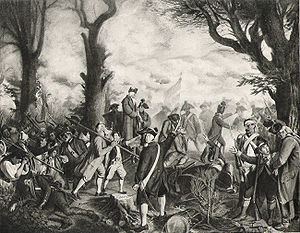 | ||
Results Decisive French victory, Switzerland becomes a French client state Similar Battle of Emmendingen, Battle of Ostrach, First Battle of Zurich, Battle of Schliengen, Siege of Bellegarde | ||
The French invasion of Switzerland (French: Campagne d'Helvétie, German: Franzoseneinfall) occurred from January until May 1798 as part of the French Revolutionary Wars. The independent Old Swiss Confederacy collapsed, both by this foreign invasion and simultaneous internal revolts, termed the "Helvetic Revolution". Its Ancien Régime institutions were abolished and replaced by the centralised pro-French Helvetic Republic.
Contents
Background
Before 1798, the modern region of Vaud belonged to the Canton of Bern, to which it had a dependent status. Moreover, the majority of Francophone Catholic Vaudese felt oppressed by the German-speaking Protestant majority of Bern. Several Vaudese patriots such as Frédéric-César de La Harpe advocated for independence. In 1795, La Harpe called on his compatriots to rise up against the Bernese aristocrats, but his appeal fell to deaf ears, and he had to flee to Revolutionary France, where he resumed his activism.
In late 1797, French general Napoleon Bonaparte, who had just successfully conquered northern Italy and founded the Cisalpine Republic, pressed the French Directory to occupy Switzerland; soon 10,000 troops gathered near the city of Genève. Valtellina, Chiavenna and Bormio, dependencies of the Three Leagues, revolted and with French support seceded from the Confederacy to join the Cisalpine Republic on 10 October 1797. In December, the southern part of the Prince-Bishopric of Basel was occupied and annexed to France. The atmosphere inside Switzerland had changed significantly due to these developments, and many pro-French patriots hoped, and anti-French conservatives feared, that the Revolution would now spread to the rest of the Confederacy, with or without direct French military intervention. France used the dissatisfaction of the rural elites in the dependencies and the Enlightened citizenry in the cantons to stimulate revolutionary excitement.
The first event of what would become known as the "Helvetic Revolution" happened with a patriot uprising in Liestal in the Canton of Basel on 17 January. The rebels demanded legal equality, erected a liberty tree and burnt down three Vogtei castles by 23 January. On 24 January 1798, the urban elite of Vaud proclaimed the Lemanic Republic (French: République lémanique) in Lausanne, which became its seat of government. Next, citizens and subjects in countless Swiss cities, cantons and their dependencies rebelled, and after the example of Vaud, more than 40 other short-lived republics were proclaimed in February, March and April throughout the country.
Invasion
At the invitation of French-speaking factions in Vaud, 12,000 French troops under general Ménard invaded Vaud on 28 January. An alleged incident, in which French soldiers were killed by Swiss soldiers, was cited as an pretext. They occupied Vaud without resistance and were cheered on by the population. A second army under general Schauenburg advanced from Mont-Terrible, the former Prince-Bishopric of Basel, towards Bern and demanded its government to put pro-French Revolutionary parties in power. The Bernese refusal to do so was used by the French to justify war. On 3 February, the Légion fidèle or "Loyal Legion" was formed out of French-speaking volunteers from Vaud who wished to stay loyal to Bern and recapture the Lemanic Republic.
There were minor skirmishes on 2–5 March 1798, leading to the swift collapse of the Old Confederacy. On 5 March, the French attained a clear victory in the Battle of Grauholz over the Bernese forces, confirming Vaud's secession. It led to even more dependencies across Switzerland declaring themselves independent republics. However, the Directory desired a single central republican state at France's eastern border, not dozens of small ones, and steered towards (re)establishment of national unity, though this time with equality for all its subdivisions. A new Constitution had already been written in Paris by Peter Ochs and approved by the Directory. Many Swiss rebels detested it, and the National Convention in Basel passed a modified version, which was then adopted by many other entities, but the French government insisted on the original. A proposal by Supreme Commander Guillaume Brune on 16 and 19 March to divide Switzerland into three republics was also overruled; Paris enforced its design.
On 12 April 1798, 121 cantonal deputies proclaimed the Helvetic Republic, "One and Indivisible". The new régime abolished cantonal sovereignty and feudal rights. The occupying forces established a centralised state based on the ideas of the French Revolution. The clashes of April and May represent the last pockets of resistance against the recently established Helvetic Republic. The Nidwalden uprising (Schreckenstage von Nidwalden) in September was more serious, with 435 dead, including 118 women and 25 children. Its repression confirmed the new political situation.
Aftermath
The invasion strained the recently concluded Treaty of Campo Formio (18 October 1797) that had ended the War of the First Coalition against France. Now, the European monarchies once again feared republican France was expanding its grip on the continent, and had to be opposed and driven back. The French conquest of Switzerland, which had maintained its neutrality ever since the outbreak of the French Revolution, was one of the reasons for the formation of the Second Coalition, and would see an Austro-Russian army conduct the Italian and Swiss expedition in 1799 and 1800.
